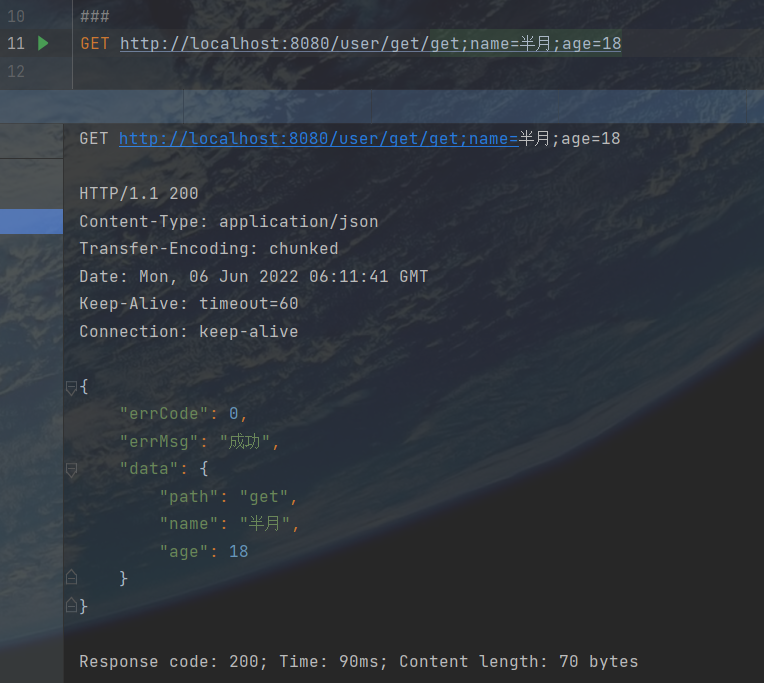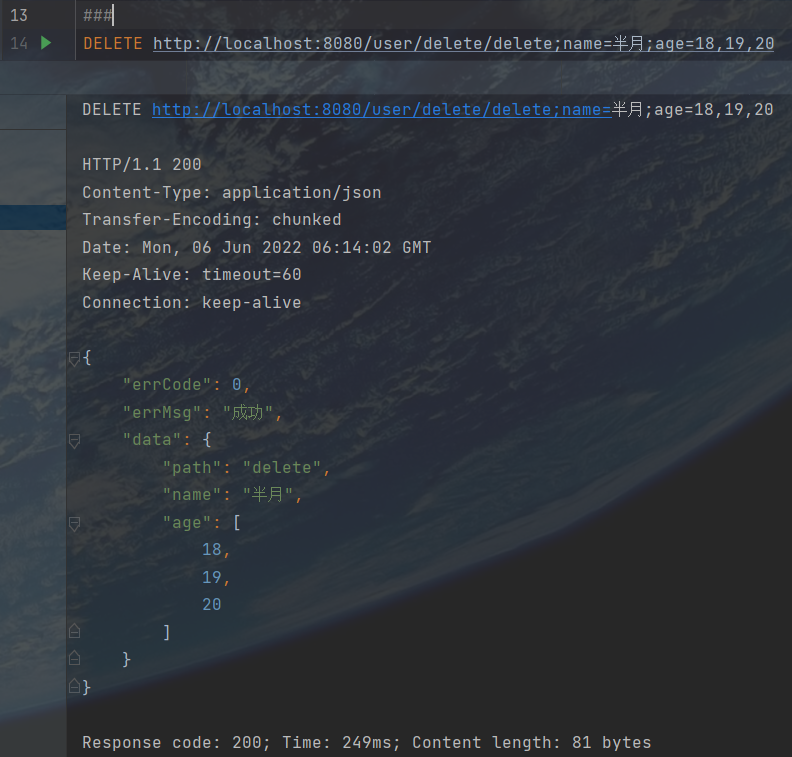SpringBoot使用矩阵传参
一、介绍
在平时,我们在进行请求接口时,我们一个请求url的样子往往是下面这样子的
1
| http://localhost:8080/user/get?name=半月&age=18
|
对于上面的请求url,我们只需要使用@RequestParam注解就可以将其获取,十分简单。
那么,对于下面的这个矩阵传参的url,我们该如何进行获取呢?
1
2
3
| http://localhost:8080/user/get;name=半月;age=18
http://localhost:8080/user/delete;id=11,12,13;status=1
|
这时候,我们就该使用到@MatrixVariable这个注解了,具体使用如下。
二、使用
1)基本使用
在springBoot中,默认是去掉了url分号后的内容。如此一来,我们在使用矩阵传参时,需要对其进行开启。
1
2
3
4
5
6
7
8
9
10
11
12
13
14
15
16
17
| package com.banmoon.test.config;
import org.springframework.context.annotation.Configuration;
import org.springframework.web.servlet.config.annotation.PathMatchConfigurer;
import org.springframework.web.servlet.config.annotation.WebMvcConfigurer;
import org.springframework.web.util.UrlPathHelper;
@Configuration
public class MyWebMvcConfig implements WebMvcConfigurer {
@Override
public void configurePathMatch(PathMatchConfigurer configurer) {
UrlPathHelper urlPathHelper = new UrlPathHelper();
urlPathHelper.setRemoveSemicolonContent(false);
configurer.setUrlPathHelper(urlPathHelper);
}
}
|
或者可以这样写,效果都是一样的,熟悉@bean配置的大家都知道。推荐使用上面这种,简单明了
1
2
3
4
5
6
7
8
9
10
11
12
13
14
15
16
17
18
19
20
21
22
23
24
| package com.banmoon.test.config;
import org.springframework.context.annotation.Bean;
import org.springframework.context.annotation.Configuration;
import org.springframework.web.servlet.config.annotation.PathMatchConfigurer;
import org.springframework.web.servlet.config.annotation.WebMvcConfigurer;
import org.springframework.web.util.UrlPathHelper;
@Configuration
public class MyBeanConfig {
@Bean
public WebMvcConfigurer webMvcConfigurer(){
WebMvcConfigurer webMvcConfigurer = new WebMvcConfigurer() {
@Override
public void configurePathMatch(PathMatchConfigurer configurer) {
UrlPathHelper urlPathHelper = new UrlPathHelper();
urlPathHelper.setRemoveSemicolonContent(false);
configurer.setUrlPathHelper(urlPathHelper);
}
};
return webMvcConfigurer;
}
}
|
对于下面这两个url请求,我们可以这样写接口
1
2
3
| http://localhost:8080/user/get/get;name=半月;age=18
http://localhost:8080/user/delete/delete;name=半月;age=18,19,20
|
1
2
3
4
5
6
7
8
9
10
11
12
13
14
15
16
17
18
19
20
21
22
23
24
| package com.banmoon.test.controller;
import com.banmoon.test.dto.ResultData;
import org.springframework.web.bind.annotation.*;
import java.util.HashMap;
import java.util.Map;
@RestController
@RequestMapping("user")
public class UserMatrixVariableController {
@GetMapping("/get/{path}")
public ResultData get(@MatrixVariable String name,
@MatrixVariable String age,
@PathVariable String path){
Map<String, Object> map = new HashMap<>();
map.put("name", name);
map.put("age", age);
map.put("path", path);
return ResultData.success(map);
}
}
|
请求查看结果


2)其他
另外一种请求url,看着很乱
1
| http://localhost:8080/user/setUserPost/101;status=1/post/111;status=1
|
接口是这样的
1
2
3
4
5
6
7
8
9
10
11
12
13
14
15
16
17
18
19
20
21
22
23
24
25
26
| package com.banmoon.test.controller;
import com.banmoon.test.dto.ResultData;
import org.springframework.web.bind.annotation.*;
import java.util.HashMap;
import java.util.Map;
@RestController
@RequestMapping("/user")
public class UserMatrixVariableController {
@GetMapping("/setUserPost/{userId}/post/{postId}")
public ResultData setUserPost(@PathVariable Integer userId,
@PathVariable Integer postId,
@MatrixVariable(value = "status", pathVar = "userId") Integer userStatus,
@MatrixVariable(value = "status", pathVar = "postId") Integer postStatus){
Map<String, Object> map = new HashMap<>();
map.put("userId", userId);
map.put("postId", postId);
map.put("userStatus", userStatus);
map.put("postStatus", postStatus);
return ResultData.success();
}
}
|

三、最后
在处理完矩阵传参后,我就知道这玩意有多么不受待见了,我也搞不懂会有什么样的业务场景去使用这种传参模式。
好吧,可以不用,但不能不知道。
我是半月,祝你幸福!!!














